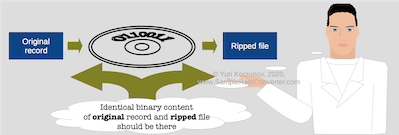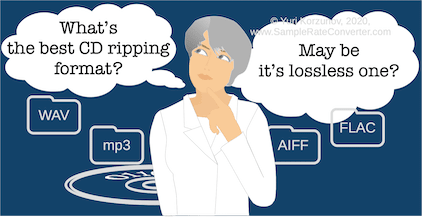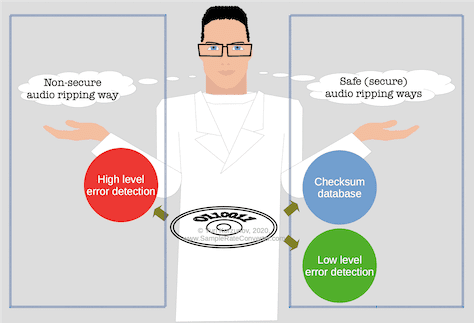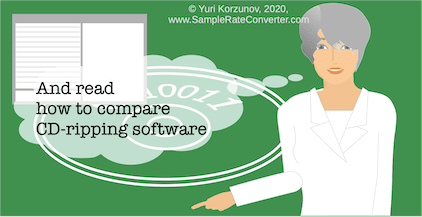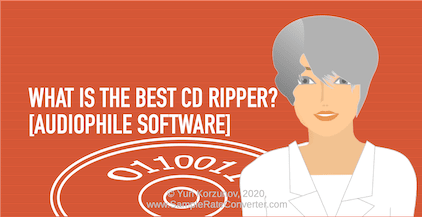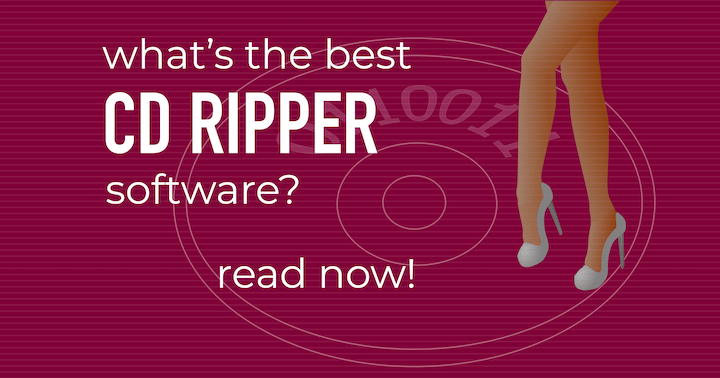
Audio Basis - articles about audio
CD ripper software is intended for copying CD audio content to music files on hard disc of a computer. Read below about:
• sound quality,
• different ripping ways (including safe/secure and unsecured),
• ripping formats and settings,
• metadata management;
• Frequently Asked Questions;
• what is the best CD ripping program (Mac, Windows, Linux) for audiophile.
- CD ripper software for audiophiles
- Common ripping issues
- A CD ripper software features
- Sound quality
- What is the best CD rip format
- Are CD ripping errors audible?
- What cause CD ripping fault
- CD ripping fault detection
- What is the best CD rip settings
- How to compare CD rippers?
- Metadata for ripped songs
- Frequently Asked Questions
- Conclusions. What is the Best CD Ripper?
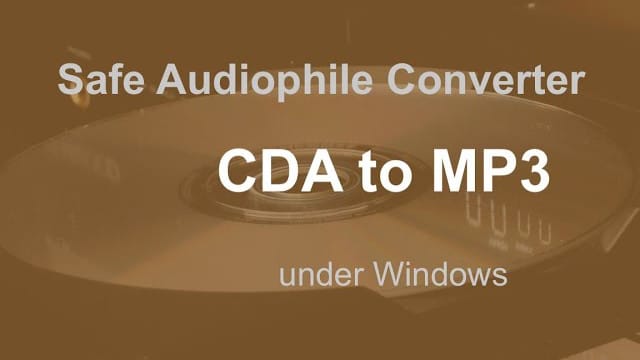
CD ripper software for audiophiles
Disclaimer: The list may contain mistakes and does not reflect the current version of a stand-alone CD extractor software. If table cell is empty, the author hasn't exact information. If you found an error contact us. We produce AuI ConevreR 48x44.
Read the comparison of CD rippers for Windows, Mac, and Linux. Apps popular among audiophiles included.
- AuI ConverteR 48x44
Safe CD ripper with original technology of deep error detection by Audiophile Inventory (safeR). If the errors are detected, the program attempts recover data.
Also, the ripper allows forces 1x rotation speed for safety. If you are sure in a compact disk integrity, use fast ripping mode.
Loudness normalization. Gapless conversion of seamless albums like operas, concerts. Count clipping in conversion. Multi-CPU processing of audio obtained from CD.
Rips compact disc to WAV, FLAC, AIFF, ALAC, m4a (iPod, iTunes, Apple Music), DSF, mp3, others. Resolutions up to 1536 Hz / 64-bit, DSD1024 depending on file format.
Track metadata obtained from free online database. Meta-tag editor WAV, FLAC, AIFF, DSF.
Multilanguage graphical user interface.
Free / Commercial
Windows 11, 10, 8, 7 (x32/x64/arm),
Mac (Intel, Silicon) Maveriks, Yosemite, El Capitan, Sierra, High Sierra, Mojave, Catalina, Big Sur, Monterey, Ventura, Sonoma
Windows Mac - CDex
Access to online database to get metadata. Converts to mp3, FLAC, ogg, AAC, WAV, others. Obtains metadata from Internet database. Normalization of audio.
Open source. Multilanguage interface.
Windows 10, 8.1, 8, 7, Vista, XP
- Cdparanoia
App with secure ripping algorithm. Convert to WAV, AIFF(compressed AIFC version).
Free
Linux
- dBPoweramp
App with secure ripping by Illustrate. Supports WAV, AIFF, AAC, FLAC, Apple Lossless (ALAC), mp3, m4a, WMA.
DSP effects. Checksum database. Metadata database. Multi-CPU encoding. Metadata editor.
Time limited demo / Commercial
Windows, Mac
- EAC
Ripper program that allows secure ripping. Output WAV, mp3, WMA, FLAC, OggVorbis.
Volume normalization to target percentage.
Checksum database. Metadata database. Small WAV editor. For some drives, supports CD writing.
Free
Windows
- foobar2000
Checksum database.
Metadata database.
Free
Windows
- iTunes
Audio player application with builtin CD ripper by Apple. The ripper has error correction correction. It should be turned on in the software settings.
CD track metadata are obtained from internet database.
Free
Windows, Mac
- Phile Audio
CD ripping application with encoding to different audio formats. Commercial
Mac
- XLD
The application is decoder, converter and player for lossless audio files. The program has plug-in abilities.
Program with safe ripping.
Checksum database.
Metadata database.
Free
Mac (PPC, Intel, Silicon)
- Windows Media Player
CD ripping app by Microsoft.
Search metadata for ripped files.
Free
Windows
More CD rippers for Ubuntu Linux

If you buy "AuI ConverteR PROduce-RD" (2023/12.x version) from 24 August 2023 to 24 October 2023, you will get free update to version 2024 (13.x) after its release.
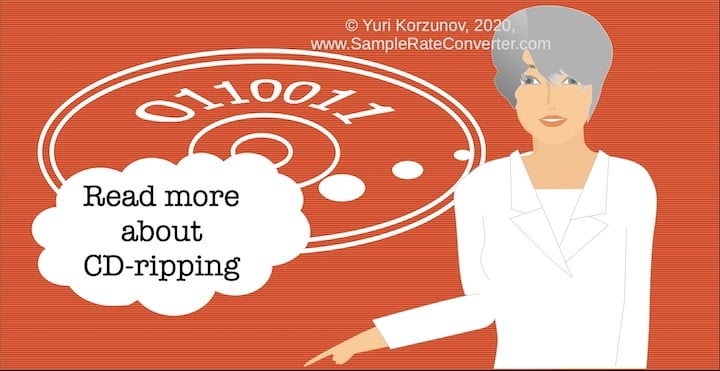
Disclaimer: In this article theoretical concepts are discussed. Real programs and hardware are not discussed here and may work differently. All stuff here is a personal opinion of the author. And the stuff is based on the author's knowledge at the time of the article writing.
Back to topCommon ripping issues
You can meet the topic of the article too often at the forums and articles, like: "the best cd ripping software", "the best cd ripper", "the best cd ripper for mac", "the best cd ripper for windows", etc. The rippers are compared by perceived sound quality, functionality, metadata (song information: track name, album, performer, etc.) abilities, ripping speed and other.
However, in the author's opinion, the main feature of the best cd ripping software for audiophiles is the copying exactness of CD binary audio data to music files.
This feature is measurable. But the author doesn't know about studies, that are available for public access.
CD ripping in simple words
Digital music is a number sequence. The numbers are packed in bytes.
Thus, digital audio is a byte sequence. Byte is a piece of digital information.
If one or several bytes are broken, music can get audible distortions.
If a CD ripper can't exactly read values of the bytes, written at a recording studio, we get broken sound.
EXAMPLE:
Remark: It's only an approximate CD-ripping description. The real process is more sophisticated.
At a factory, we should put several ice cubes (bytes) in a box (song on CD).
These cubes are different.
Some of the cubes may be damaged when put in the box or during delivery. It's like, bytes are damaged in manufacturing or another way.
CD ripping is like the creation of cubes into our own box (ripped sound files).
When we study the cubes (read from CD), we can find 3 types of damaged cubes (wrong bytes):
- If the cube (byte) is lost its corner, we can create similar-size cube (restore information in byte) and put it in our box (ripped music file).
- If we have a corner instead full cube (unrecovered information), we can't restore the cube (byte) exactly. It happens due to we know nothing about the cube size.
- We can't distinguish corner (case 2) and part of the cube (case 1).
We can look at the cubes (bytes on CD) through different glass types (optical drive with CD ripping program).
The glass type (ripper application and optical drive) defines how exactly we can detect the ice cube size (byte value on CD) and restore the initial cube size into our box (byte value into ripped file).
A safe or secure CD ripper is a computer program that has exactness of binary-content copying as the main aim.
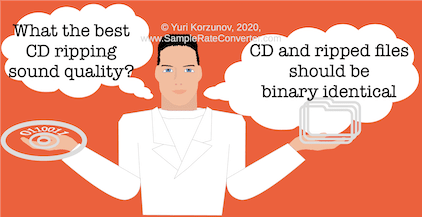
Read below:
- sound quality issues;
- how to provide the exactness and how it linked with ripping speed;
- damaged CD music information restoration;
- best CD rip format and settings.
Back to top
A CD ripper software features
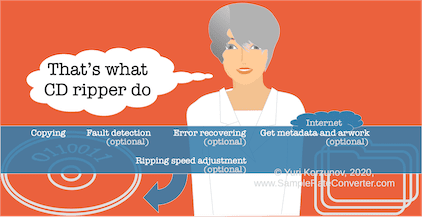
- Copying music binary content from CD tracks to sound files
- Copying optical disc fault detection
- Attempt of damaged audio restoring
- Ripping speed
- Embedding text metadata and album artwork (auto and/or manual)
- Resampling and bit-depth altering
- Creating directory structure to ripped files
Read below the review of audio data integrity control (quality issues), ripping speed and audio-information restoration.
Back to top
Sound quality
Quality of CD ripping is a number of broken bytes in the ripped files. The best quality is 0 broken bytes.
CD ripping error is a digital audio data difference between original record (binary audio file content that is intended for CD pressing) and audio content of a ripped file.
Original record is an audio file that is used to produce a compact disc.
Correct error detection is a correct detection of real broken byte.
False (wrong) error detection is an error detection for correct music information.
Abbreviations
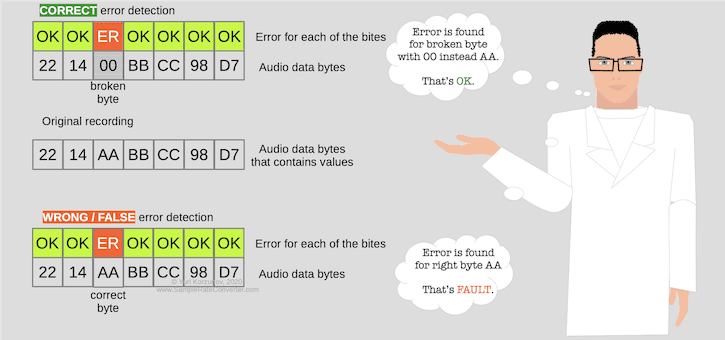
Maximal CD ripping quality is ripping without errors. I.e. binary music content of a ripped file should be fully identical to original record.
In the first approach, CD ripper program can't improve sound of CD.
The best thing that can do the application is binary-exact copy of music information from optical disc to sound file only.
However, there are some details. If optical drive of computer makes fewer errors, than CD-player device, ripped sound files are closer to the original master record. It's important to remember, that hardware players have their own ways of restoration for broken music.
The word "probably" is used too often in the article, because error rising, correct or false error detection, error fixing are not events with 100% probability.
What is the best CD rip format
If your aim is binary audio data capturing as is, use any lossless PCM format:
- WAV,
- FLAC,
- AIFF,
- ALAC,
- APE,
- etc.
If you would to reduce lossless file size, use FLAC.
If your aim is maximal file size reducing - use lossy mp3 or AAC format.
For DSD DAC or digital audio player, DSF format may be recommended.
However, for optical discs, ripping to backups in lossless file formats (WAV, FLAC, AIFF) is recommended.
After it, you can convert these lossless backups to mp3, DSF or other format.
It allows saving time of slow audiophile ripping procedure.
Read what is the best CD ripping format >
Are CD ripping errors audible?
Yes. Some CD ripping errors are audible. As rule, it may be silence, sound interruption(s), pops/clicks. Rarely, periodical short-time errors may degrade sound not as obvious. It causes a "strange" distorted sound.
Back to topWhat cause CD ripping fault
Digital music stream faults can cause either clicks or pauses or interruptions or other audible distortions.
Back to top
CD ripping fault detection
There are different ways of ripping-error detection:
- high-level fault detection,
- ripping-checksum comparison for numerous identical discs,
- low-level fault detection.
High level CD-fault detection
In this case CD, audio stream is read:
- without error flags,
- without re-readings,
- with buffering of reading information.
Audio information is corrected by optical drive anyway.
But there are some ways of additional ED are missed (read details "Low-level CD-fault detection" part).
Sometimes, optical device driver of operating system can report about fault, sometimes - not. It depends on implementation driver and operating system. CD ripper doesn't obtain error flags, generated by compact disc drive, and stores music information as is into files.
CD checksum comparison with database
This secure way calculates ripped CD's checksum. These checksums are collected into an internet database. When you rip CD at the database-compatible ripping software, your rip checksum is calculated and compared with checksums in the database.
But the database doesn't contain original record checksum. So ripped checksum compared with an array of uncertified checksums.
We can hope (without 100% warranty), that the majority (of similar checksums for some CD in the database) is the same checksum of the CD's original record.
But, in instance, if some CD series was manufactured without 100% identity to original studio files (for unknown to us reasons), then we have non-correct majority.
If a CD ripper (that is used for copying the majority) has a non-fixed bug, the same situation may happen too.
Also, rare record or different optical disc versions (pressing, mastering?) issues may be there.
Low-level CD-fault detection
This secure/safe way is based on:
- own abilities of CD drive
- ripper program's statistics collection by multiple re-readings of your optical disc.
CD-drive can correct faults and restore (with some probability) valid audio information (Reed–Solomon coding) [1][2].
So compact disc drive try to detect faults inside. If it is detected, the drive tries to restore music information. In case of unsuccessful fault elimination, error flag (C2) mark a broken byte.
The safe/secure compact disc ripper app may apply additional fault detection and correction algorithm under data, that was before checked and corrected into CD drive.
Raw audio stream from CD-drive is read with C2 flags, re-readings and with buffering elimination of reading data.
Several re-readings of CD-drive's music data can cause different binary content for re-readings.
This difference combined with С2 flags can give new information about faults, that were probably missed into CD-drive.
One error flag control audio data integrity of 1 byte of the raw audio information. The flag is calculated by CD drive. Probably, some drives can't calculate it. But, I suppose, it is a matter of older drives.
Re-reading is repeated reading of CD track's fragment. Re-reading performed several times.
Buffering elimination is an attempt of forced cleaning of CD data buffer for each re-reading. Re-reading from music data buffer have no sense, because there is same information for each re-reading. But repeatable audio data reading from CD can cause different content in problematical places.
Further, the obtained data array is analyzed to additional ED.
This method also doesn't guarantee 100% probability of audio stream integrity.
However, there is no additional element of uncertainty like a database without original record checksum.
Ripping speed
CD extractor can begin to read information at maximal speed to save time. When compact disc ripper read music information and get fault (as from optical disc drive, as by the data analysis), it can reduce reading speed to safer extracting. Of course, it consumes more time.
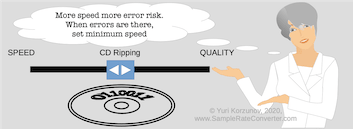
Ripping speed depends on own CD drive's correct reading ability.
CD reading speed should provide maximal available safety of extracted music information.
If CD ripper use re-readings, it decreases total ripping speed anyway, even for constant rotary speed.
Because in safe/secure mode compact disc is read several times, instead one time in unsafe mode.
Simultaneous use of CD's checksum comparison and low-level fault detection
Correct error-detection is an event when both sources (safe CD ripper and checksum database) detected "ripped information is valid".
Warning:
"Correct error-detection" and "correct ripping" are different events.
"Correct error-detection" happens when a ripper detect errors correctly relatively binary content of source studio audio file, that is used to CD manufacturing.
"Correct ripping" happens when binary audio content of ripped file is identical to binary content of the source studio audio file.
If "correct error-detection" is happening, it means that "correct ripping" doesn't happen.
Total correct error-detection probability (CEDP) of the safe ripper:
- without the checksum database: CEDPwod=CEDPcd
- with the database: CEDPwd=CEDPcd * CEDPdb
CEDPcd is [CD drive + CD ripper] system's correct ED probability (CEDPcd <= 1.0)
CEDPdb is the dababase's correct ED probability (CEDPdb <= 1.0)
Ideal theoretical value of CEDPcd and CEDPdb is 1.0. But real values are lesser 1.0 always.
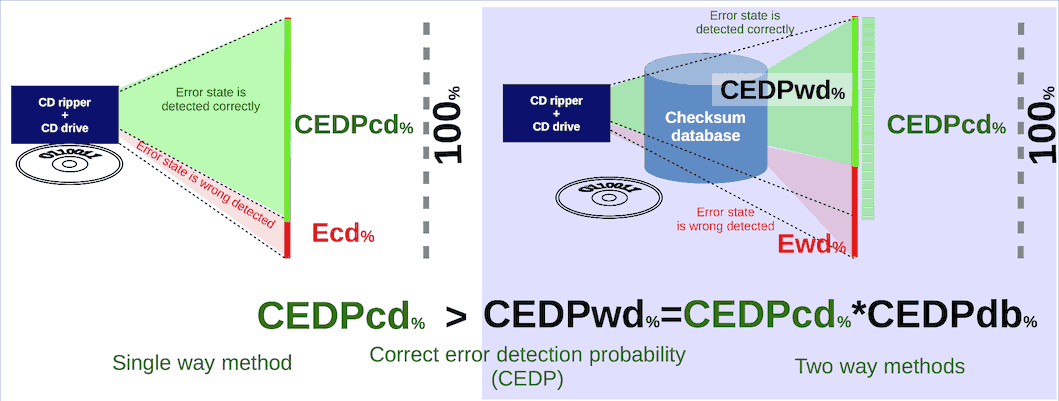
Result of multiplication CEDPcd to value, that lesser 1, is lesser than CEDPcd.
Thus, CEDPwd < CEDPwod ("with database" lesser than "without").
There is no known information, what is higher: correct ED probability of [CD drive+ripper program] system or database.
Simultaneous use of both methods reduces total correct error-detection probability of CD ripping.
Generally, separate using only one of these two methods is recommended to decrease result uncertainty.
You can choose method, that is more suitable for you by other functionality (data restoration, in instance, or other).
Though mistake in method choice can cause lesser total correct error detection probability.
Attempt of CD audio data restoration
The ripper software read data array (raw audio data and error flags after several re-readings) and use it to create probable correct content at damaged places (without 100% guarantee, of course).
Some data can't be restored (fatal faults).
Read about one of safe CD ripping technology >
What is the best CD rip settings
Most complex ripping part is safe reading from optical disc. For some discs, it may be unstable.
Generally ripping into 16 bit / 44.1 kHz PCM backup (WAV, FLAC, AIFF, etc.) without any processing is recommended.
Check your CD ripper settings to turn off any processing (resampling, dithering, gain, etc.).
These ripped backups you can use for further conversions to target musical devices (portable audio player, mobile phone, car audio, music server, etc.).
Back to topHow to compare CD rippers?
Fortunately, we can objectively compare CD rippers by ripping quality.
This comparison can't cover all cases. Because test result can depend on damaging kind of test CD.
1. Tools
1.1. CD rippers
1.2. CD-drive(s)
1.3. Test CDs with binary identical WAV files per track.
The test CDs should have different
1.4. Tool for binary comparison of WAV files.
2. Testing rippers
2.1. Rip the test CDs to WAV files for different combinations:
a) CD ripper program
b) Compact disc drive
c) CD ripping mode (speed, overlapping, re-reading number, recovering, etc.) if available.

2.2. Compare ripped WAV files with original files (sources of tracks of the test CDs) via binary comparison tool (goal 1.4):
a) Length in bytes from beginning of the track to first detected (via binary comparison) fault byte.
Register it in results as mark of steadiness CD extractor to fault appearing.
b) Percent of detected (via binary comparison) wrong bytes to total number of bytes in track.
Register it in results asmark of ability CD extractor to fault avoiding.
During WAV file binary comparison need consider audio data only (pass by WAV’s header and non-audio chunks).
Recommended provide several times (10 and more) rippings in combination
{[test CD]+[CD ripper]+[CD ripping mode]+[CD drive]}
It needs to be addressed possible byte offset between original WAVs and ripped ones.
If the offset is present, superpose original and ripped WAV files.
To superpose refer to identical binary sequences of audio data. Found identical binary sequences in original and ripped WAV files and shift compared binary content to match the sequences.
As begin of track considered begin of original WAV's audio data.
3. Comparing results of the tests
Integral mark of the tested system [ripper + ripping mode + CD drive] is averaged by different test CDs.
Test resume makes by comparison of the integral marks of the systems.
Back to top
Metadata for ripped songs
Some CD rippers are able to automatically request of track metadata (metatags): song and album name, year, performer for internet database.
Some databases contain album artworks.
When ripping is started, the ripper forms an unique ID of compact disc by its track start addresses, in instance.
Sometimes database contains several entries for a single disc (in instance, at different languages).
Some rippers enable to assign metadata and/or album artwork file manually before or after ripping.
There are databases:
Free:
- gnudb.org (former www.freedb.org)
- www.discogs.com
Commercial:
Back to topFrequently Asked Questions

What is the best way to rip CDs?
The best way to rip CD-audio is using of a system (CD-ripper software + optical disk drive), that cause lesser reading error number. Such things as jitter, color marker pen to covering disk surface or side and other same things is not matter for you. Read details...
Read also:
What's the best ripping format...
What is the best way to digitize my CD collection?
The best way to digitize your CD-audio collection is using of a CD ripping program.
Which CD ripper is best?
CD rippers have different methods of audio data reading from compact disc.
Read more about:
What is the best program to rip CDs?
As far as the author knows, it's too difficult to find technically correct CD ripper comparison in public sources. The comparison should show error that a tested ripper brings to output sound files.
However, you can try to make own comparison even at home.
What is the best quality to rip CDs?
To protect full audio information of CD, it should be ripped in 44.1 kHz / 16 bit without audio processing.
Some CD rippers may detect and correct errors. But it's doesn't mean that original audio data will be restored with 100% warranty.
Read details...
If you want to optimize ripped stuff to your DAC, read the article...
Can I digitize my CDs?
CD contains already digital audio. You can copy its content directly in the digital form. Read more...
Can all CDs be ripped?
If an audio compact disk contains serious or too many errors, it can not be ripping with proper sound quality. Also, the CD may be compressed special way.
What is the fastest way to rip CDs?
Fastest way is rip CD is rip it at maximum sampling rate without repeatable reading. However, it's not safe way of compact disc ripping in some cases. Read more...
How do I rip an entire CD?
Read the guide How to rip CD...
How do you rip a CD on a Mac?
Read how you can rip a CD on a Mac...
How do I rip a CD on my Mac without iTunes?
You can rip a CD audio on your Mac without iTunes. Read how to do it...
How do I rip a CD with lossless Mac?
How to rip a CD to lossless audio on Mac, read the guide...
How do I transfer music from a CD to a USB on a Mac?
You can transfer music from a CD to a USB-storage on a Mac via CD ripper software.
Select a directory on the storage as taget folder for files that extracted from the compact disk.
How do I convert a CD to MP3 on a Mac?
To convert a CD to mp3 on a Mac you can use CD ripping program.
How do I rip CDs in Windows 10 or 11?
Read the user manual: How to rip CD on Windows...
What quality should I rip CD?
First aim is exract CD content with original quality (resolution 16 bit / 44.1 kHz) without errors. If you want to optimize ripped music files to your audio system, you can resample this resolution in ripping or later. Read details...
Are CDs uncompressed?
Most of CDs contains uncompressed PCM in 16 bit / 44.1 kHz.
However, there are DTS- and MQA-CDs.
Read more about audio formats...
Why can't I rip a CD?
There are several reasons:
- CD is not audio;
- [Windows only]CD contains both audio and data. And you can see the data in a Windows file manager;
- [Windows only] you can't copy *.cda files directly. Because they are only index files, that don't contain audio data;
- CD is damaged.
Read the user manual: How to rip CD [Mac, Windows]...
Is CD ripper free? How do I rip CDs for free?
To look for best free CD-ripper, see the list...
Does ripping music from CD damage it?
Some ways of CD ripping can cause an additional mechanical load to CD. But, the author knows nothing about CD, damaged by ripping.
Fast or express CD ripping on first speed is the same usual CD playback.
What is the best quality to rip a CD?
Best quality to rip CD is ripping without digital data errors.
Also, you can adapt ripped music to you digital-to-analog converter.
Read more...
How do I rip high-quality CD to mp3?
Read quick start guide...
Is it worth ripping CD to FLAC?
Ripping to FLAC has the same quality WAV. But it allow saving hard-disk-drive space. It is especially important for mobile devices. Read quick start guide...
Does VLC rip CDs?
In general, VLC can rip CD. As the author know, additional efforts are need to batch ripping. Maybe latest VLC version solve the issue.
Can Audacity rip a CD?
As the author know, Audacity can't rip CD. However, under Mac, CD is mounted as a HDD with .aiff files, that contains audio data. However, undetected CD errors may be matter for this access type to compact disc.
How do I rip a CD to MP3?
Read how to rip CD-audio to mp3...
How do I rip a CD to FLAC?
Learn how to rip CD to FLAC...
Can I use iTunes to rip CDs?
Yes. iTunes has functionality to rip CD.
What is the best quality to rip CDs to iTunes?
ALAC, AIFF or WAV audio formats are recommended. Sampling rate and bit depth choose according to your DAC.
Read more...
How good is Apple Lossless format?
Apple Lossless is lossless audio format. It provides highest sound quality.
About alternatives read here...
Is Apple Lossless as good as FLAC?
Yes. Both Apple Lossless and FLAC formats are lossless.
Read more...
What do I do with all my CDs?
You can rip your CDs to computer files. Read details...
How many CDs will 2TB hold?
One compact disk has size about 600 GBytes. 2TB holds about 333 CDs.
Back to top
Conclusions. What is the Best CD Ripper?
The main useful audio ripper feature is copying exactness of audio data from compact disc to file. In the ideal case the data should be extracted without changes.
For valid CDs it does not matter. In the first approach, all CD rippers will work identically there. Except for false error detection case.
But some CDs, especially damaged, may contain errors. And CD extractor should found the faults. It's desirable, the ripping program attempt to restore damaged data that was found.
I.e. we can choose (as the best) the ripper that makes minimal fault number in ripped data.
In the article comparison method of audio rippers is suggested.
Unfortunately, the author doesn't meet results of independent ripper quality researches in the open sources.
Using of checksum database allows comparing own ripping results with other ones, but original record checksum is unknown.
The author rather recommend to choose one of CD rippers (free or paid), that have low-level error detection with CD drive, providing C2 error flags. It enables direct control over ripping errors without referring to uncertified third-party sources.
Simultaneous use of both methods is not recommended, because case, that both methods show different results, is probable.
The simultaneous use can reduce the probability of correct error detection.
- What is safe CD ripping audio >
- The Best Format to Rip CD Audio: How to Choose [Article] >
- Rip Audio CD [Frequently Asked Questions] >

Back to top
